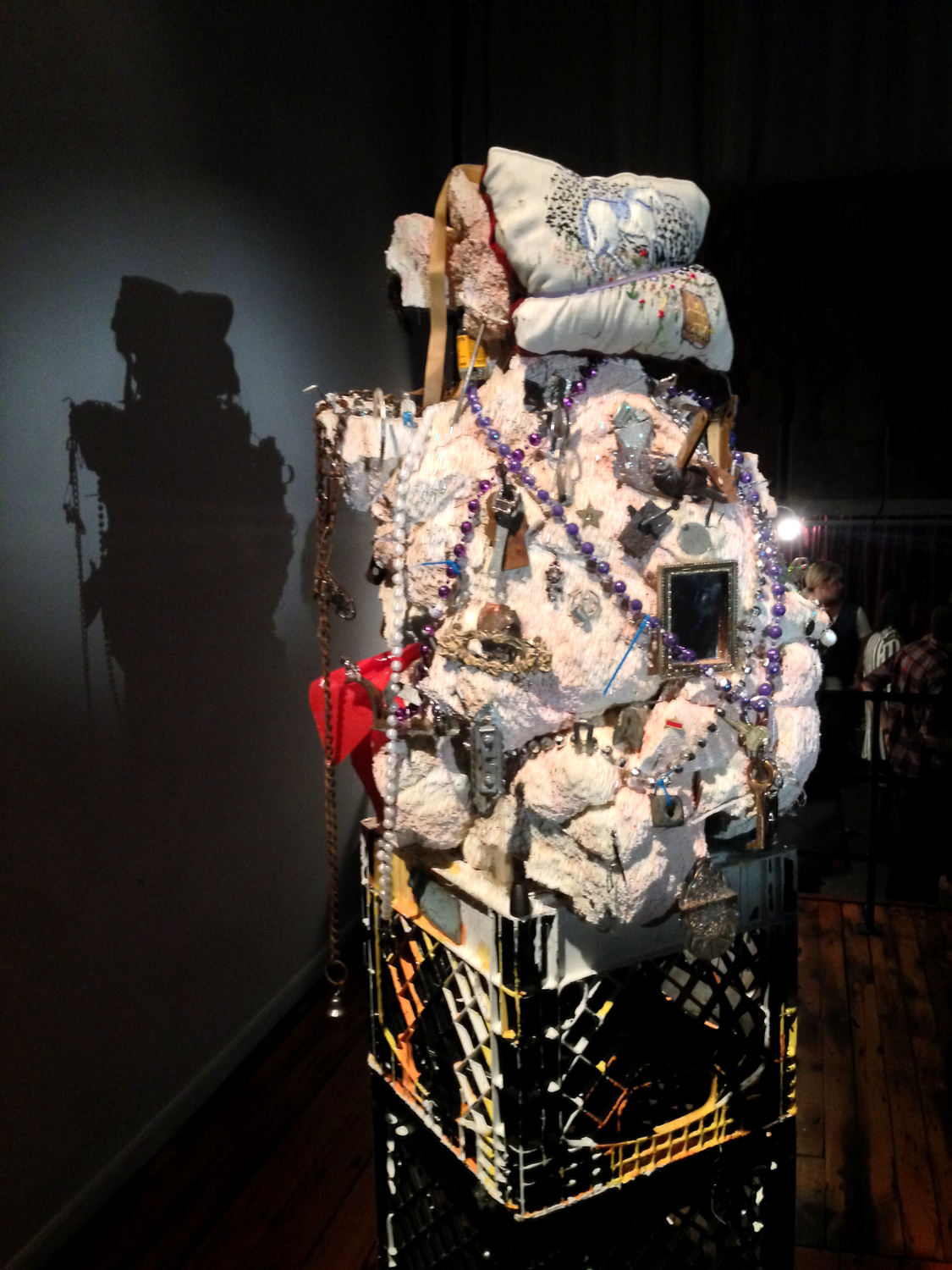
Jeremiah Jones neither worships nor despises technology: he uses it. In a time when everyone seems to be worried that the world is becoming superficial, Jones’s show, “It’s Kind of Awesome to Be the Precariat,” uses cellphone videos, animations, found objects, condom wrappers, fake jewelry, and heavily saturated light to remind us of the sincerity of images. Though it is frightening to be powerless in an industrialized, technology-filled era, Jones defends the integrity of our subjective experiences in a capitalist world.
Jones’s show, at ROOMS in Pilsen, is housed in a softly lit gallery, like a house with only the kitchen lights on. As you enter the room, you are immediately drawn to a collection of glitter-filled canvasses, neatly arranged and glowing with projected videos. This animated mosaic feels especially alive because of the materials covering the canvasses: the moving images become a skin over underlying figures painted in gold, glittered arrows, puff balls, and cardboard boxes. Jones edits cellphone videos, a medium we usually leave raw, to brighten and soften them. The images themselves are captivating and playful: an animated scene in a grimy taxicab, a dancing lottery ticket, a nail in a white rectangle; in the center, in the cellphone video, a woman laughs into the camera while taking a shower in a sink.
“This installation, is kind of about OKCupid, and being drunk, and love, and confusion, and joy, and all of those things,” explained Rosa Gaia, the subject of the video. “We ended up spontaneously having a very late, very very messy night. And I went home and I took a shower in his sink.”
This is not a video of a long-lost love, but the objectification of a joyous moment with an almost-stranger, whom Jones met on the online dating site OKCupid. “I would say that it’s sincere rather than nostalgic,” Jones explains.
Having been in a ten-yearlong relationship, Jones is also fascinated by the experience of online dating, and he explores sites like Tinder. “There’s a sort of darkness to it to, you’re in a lot of short, bad relationships. And then having that take the place of this more loving long-term relationship that ended. So then you’re having sex with all of these strangers, and having the emotions that go with that. So this piece is kind of about that. There are used condom wrappers, opened and folded out so that they have a shine to [them].” The video of Rosa in the sink suggests that these online relationships can be versatile and transient, yet still meaningful.
The subject of this video fits into the larger theme of Jones’s show: the “Precariat.” This word is a combination of “precarious” and “proletariat,” a portmanteau that suggests that our instabilities and vulnerabilities stem from our very real and unstable social situation under capitalism. We cannot choose the forms of mediation that govern our interactions: objects in the street, Tinder, lottery tickets. These are out of our control. They are symptoms of larger societal trends and tools that can be scary, like capitalism and technology. We can’t get rid of these systems, but making meaning and making art may be a way to gain some sort of control, Jones’s work suggests. Maybe we objectify and aestheticize precariousness in order to render it less terrifying.
Jones’s concern with precariousness goes deeper than online dating. He is intimately preoccupied with the economic realities of living with and through technology, and the uncertainties of being the precariat. “I was a homeless child,” Jones explained, “my family stayed in shelters, we drifted around a bunch. I’ve been to jail, I’ve been in all sorts of strange situations in my life that have made me aware of how most people in the world are not in the privileged position of art students.” Jones elaborates on this focus in the title piece of his show. There is another image projected onto a canvass: a video continually loops footage of a man scratching a lottery ticket. On the canvas, Jones has boldly scribbled the title, “It’s Kind of Awesome to be the Precariat.” Jones shot the video in a convenience store with his iPhone, but the brightness of the colors, which Jones enhanced using various methods such as micro-beads and compact disks, lends a fullness to the moment that goes deeper than either pity or despair.
Jones has a fierce optimism that does not ignore or deny the sinister sides of modernity. “There is something uniquely beautiful about our relationship through images. The old guard of critical thinking on our society mediated by images is that we are alienated and turned into commodities. And in a way we are; we do live within this capitalist system. The perennial product of being the people we are now is that we have certain things that we have grown so accustomed to. That comfort food can be this terrible plastic-wrapped thing that we can still have sincere feelings about. Even though it’s maybe an unfortunate thing that has happened to us, we also have those things woven into the fabric of our being.”
“In this small but rather moving exhibit, there is an abundance of glitter. Jones embraces cheap materials, fake jewelry, online dating; things that initially represent shallow encounters, and the disposable gaudiness of consumerism. But the colors he uses are painfully beautiful, created through an impressive material inventiveness. These colors remind us that our experiences involve the mediation of our gaze: the way the artist is looking at it, remembering it, experiencing it, is what can make it beautiful.
And yet, perhaps Jones places too much hope in the power of mediation. The way Jones looks at the world renders is meaningful, colorful, and manageable. But if you remove the beautiful lights and the textural canvases and the hip gallery space, some people are just left with a Tinder photo and a lotto ticket.
